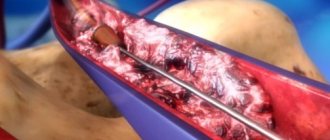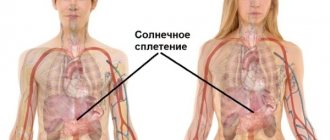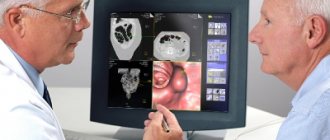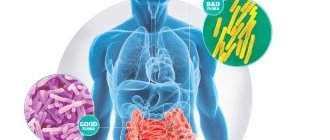Abdominal pain can occur for a number of reasons. Dividing the abdomen into quadrants, or nine areas, can help preliminarily determine the cause of pain or discomfort. How to do this can be found in our guide below.
Abdominal pain is caused by a variety of gastrointestinal disorders, from gas accumulation (flatulence) and constipation to gallstones and duct stones or peritonitis. Understanding which area of the patient's abdomen is hurting can be extremely helpful during a remote consultation with a gastroenterologist. Knowing exactly where the stomach hurts, the doctor will be able to quickly determine the cause of the disease and prescribe the correct treatment.
Right upper quadrant
Organs in this quarter: liver, gallbladder, duodenum, head of the pancreas (the part of the pancreas firmly attached to the duodenum), part of the colon.
Pain in the right upper quadrant can be caused by hepatitis (inflammation of the liver), cholecystitis (inflammation of the gallbladder), inflammation of the bile ducts (cholangitis), inflammation of the pancreas (pancreatitis), or peptic ulcers of the stomach and duodenum.
Regardless of the cause of the disease, liver inflammation is called hepatitis. Many cases of hepatitis are viral, but the disease can also be caused by alcohol, drugs and other toxic substances.
Liver inflammation can be acute or chronic. With chronic hepatitis, a person usually does not experience any symptoms. During acute hepatitis, abdominal pain, nausea, jaundice (yellowing of the skin, mucous membranes, eyes) may occur, and in more severe cases, liver problems may occur.
The most common types of hepatitis are:
- The hepatitis A virus causes acute inflammation of the liver, which in many cases resolves spontaneously without residual effects. The infection is transmitted through the feces of an infected person (due to poor hygiene conditions and habits), contaminated food and water that has not been properly cooked. Sun-dried tomatoes, fish, shellfish, and frozen berries are the most common sources of infection.
- Hepatitis B is the most common chronic asymptomatic form of abdominal pain. Hepatitis B is transmitted through blood or other body fluids. The hepatitis B virus damages the liver, causing chronic inflammation that can progress to cirrhosis and primary liver cancer. In acute hepatitis B, the course is usually violent - abdominal pain, yellowing of the skin, liver problems. Requires hospital treatment.
- Hepatitis C is also the most common chronic asymptomatic form. Transmitted through blood (highest risk for people before 1990 who donated blood or had a blood transfusion and had any surgery or dental procedures).
Types of hepatitis
The role of the intestines in the functioning of the human body
Many people are interested in where the human intestines are located.
?
With the help of this organ, the body gets rid of toxins and waste. All antibodies secreted by organs and organ systems are eliminated through the gastrointestinal tract during life. All digested unnecessary substances are excreted from the body along with feces. Here are the main functions of the human intestine
.
Small intestine
Anatomy of the human intestine
- read on. The section of the gastrointestinal tract that goes immediately after the stomach and is the longest section of the intestine. Due to the presence of a large number of villi, it is in the small intestine that further digestion and absorption of all useful substances that are needed to build the cells of the body take place. It also synthesizes a large number of hormones and vitamins. One of them is cholecystokinin. It is the most important hormone necessary for controlling appetite, giving a feeling of fullness and a good mood.
Colon
An important section of the gastrointestinal tract, it does not have loops, but it goes around the small intestine. It is important that there is a valve between the sections of the intestine. It is he who prevents the food bolus from returning from the large intestine back to the small intestine. The large intestine does not absorb useful nutrients; it absorbs water, electrolytes and vitamins. The main function of this section of the intestine is the formation and removal of undigested substances.
Peptic ulcers
Peptic ulcers are lesions of the inner lining (mucous membranes) of the gastrointestinal tract that can occur anywhere in the gastrointestinal tract, but most commonly in the stomach and duodenum. The most common symptom of an ulcer is abdominal pain.
Peptic ulcers are usually associated with the following:
- The bacterium Helicobacter pylori (H. pylori). Helicobacter pylori is a gram-negative spiral-shaped bacterium that causes chronic inflammation of the stomach and duodenum and is a common cause of infectious ulcers worldwide.
- Frequent use of NSAIDs (non-steroidal anti-inflammatory drugs), such as aspirin, ibuprofen, ketanov, etc.
- Risk factors: smoking, alcohol abuse, stress, irregular and unhealthy diet.
Peptic ulcer
Violations
Poor functioning of the digestive organ can be associated with several factors. The more factors that affect the intestines at the same time, the more severe the pathology and the more difficult it is to treat. The following reasons play a role in the development of intestinal tract diseases:
- genetic predisposition;
- weakened immunity;
- poor nutrition;
- bad habits;
- passive lifestyle;
- some medicines;
- intestinal infections.
The following symptoms unite intestinal diseases:
- Abdominal pain. The pain syndrome can be intense aching or even sharp paroxysmal. In some cases, it appears in episodes or is associated with food intake. In some diseases, patients can name a clear localization of pain, while in other disorders, the pain outbreak is diffuse. For example, when the small intestine is damaged, discomfort occurs in the umbilical region. Diffuse pain is more characteristic of intestinal bloating due to stretching of the walls by gases.
- Flatulence. This symptom occurs due to excess accumulation of gases. The cause of this condition may be fermentation processes, intestinal atony or decreased motor function.
- Decreased appetite. In fact, patients develop a fear of eating. This is explained by the fact that after a meal the intestines begin to actively contract and secrete digestive juices, which provokes painful attacks.
- Constipation or diarrhea.
Intestinal diseases usually develop against a background of weakened immunity
Heart attack
A heart attack is the death of the intestinal wall. Impaired blood flow can occur due to blockage or spasm. The insidiousness of this pathology lies in the difficulty of diagnosis. Without an angiographic study, it is almost impossible to make a diagnosis.
The pathology manifests itself in the form of sudden cramping pain in the abdomen, nausea, vomiting, and diarrhea. Given the fact that most often the disease is detected in late stages, treatment is mainly surgical. It is advisable to use conservative therapy until signs of peritonitis develop.
Dyskinesia
The pathology is based on deterioration of intestinal tone and motility. Organic damage is not detected during examination, but functional activity is significantly reduced. Dyskinesia causes indigestion. Pathology often develops against the background of neurological disorders. This is why dyskinesia is most often diagnosed in women.
Dyskinesia is divided into hypertonic and hypotonic types. In the first case, persistent spastic contractions of the intestine are observed. They can cause chronic constipation and painful colic. The pathology causes acute cramping pain in the lower abdomen and iliac regions.
The painful outbreak subsides for some time after defecation, and after eating it returns again. Chronic intoxication of the body leads to mental and physical decline in performance. With hypertensive dyskinesia, there may be no stool for several days, and then a large amount of feces is released.
With hypotension, on the contrary, peristalsis is weakened. Patients are bothered by dull painful cramps in the abdomen, a feeling of fullness, and bloating. Feces pass with great difficulty and in small quantities. This causes poisoning of the body.
Endometriosis
A benign neoplasm occurs due to the entry of endometrial cells of the uterus into other organs. Hormonal changes, hereditary predisposition, and weakened immunity play a major role in the formation of the disease. When the external intestinal muscles are affected, nausea and abdominal pain occur during menstruation. If the sigmoid colon is involved in the process, the pain attack is localized in the left lower abdomen.
The following symptoms are typical for endometriosis:
- pain in the depths of the pelvis and in the anus during menstrual periods;
- constipation or diarrhea;
- painful bowel movements;
- the appearance of blood and mucus in the stool;
- increased bowel movements during menstruation.
In women, intestinal endometriosis can cause pain during intercourse, as well as prolonged and heavy menstruation. Drug treatment is aimed at normalizing hormonal levels, since intestinal endometriosis is only a secondary process.
Lower left quadrant
The organs in this quarter are the left kidney, part of the large and small intestine, and in women, the left ovary and fallopian tube.
Abdominal pain in this quarter can be a symptom of colitis, colonic diverticulosis or kidney stones, and in women can also be a sign of ovarian or pelvic inflammation.
Sections of the large intestine
The sigmoid colon is very important in terms of absorption function.
The large intestine occupies quite a lot of space in the retroperitoneal space. It consists of several departments. They differ in length, width, functions, location:
- Cecum. In appearance it looks like a sac with a small appendage. This part is divided into the cecum itself and the well-known appendix. The cecum is small in size, its diameter rarely exceeds 10 cm. It is difficult to say exactly what role this part of the intestine plays in the digestion process. In ancient times, it was very important for the digestion and assimilation of plant foods, but then this function atrophied. The appendix is associated with the immune system, but when it is removed, intestinal functions are not impaired. There is a sphincter between the intestine and the appendix that acts as a barrier. Thanks to it, food does not get into the appendage.
- Colon. This part of the intestine is the largest section of the large intestine, so it is easily detected by palpation. It is usually divided into 3 parts, and the whole thing resembles a horseshoe or semicircle. It begins with the ascending colon (goes immediately after the cecum), then the transverse and descending colon. In this section, moisture and electrolytes are absorbed, feces become harder due to dehydration and move further.
- Sigmoid colon. It is located on the left side of the abdomen. Its name comes from the Latin letter S (sigma). It is very important in terms of absorption function: most of the liquid from food is absorbed here, and only then the absorbed moisture is distributed throughout the body. Here the formation of feces continues and their movement further through the intestines. Feces can be retained in the bends of this section, causing inflammation.
- Rectum. This section is the final section for the entire intestine. This is a very short section, the length of which rarely exceeds 15 cm. The inner layer has many mucous cells, whose work is activated during various disorders, hence the mucus in the stool. Despite the name, the intestine is not straight at all, it has bends. Here the process of breaking down food comes to an end. Everything that could be absorbed from food has already been absorbed, feces are formed and excreted from the body.
Colon diverticulosis
Diverticula are projections on the outside of the wall of the colon, commonly called “pockets.” The causes of colonic diverticulosis are not fully known. It is believed that the pathology may be associated with a congenital predisposition and constipation. Diverticulosis itself does not usually cause pain, but it can interfere with bowel movements, make bowel movements difficult, cause air to accumulate in the area, and cause bowel spasms, which can be painful.
Another cause associated with severe pain is inflammation of diverticulitis (diverticulosis). With inflammation, the pain is acute, severe discomfort, bloating, cramps, blood, mucus or pus in the stool may occur, and the temperature may rise. Antibiotics are usually prescribed and surgery is rarely required.
Microflora
The intestinal tract is inhabited by the following bacteria:
- lactobacilli;
- bifidobacteria;
- bacteroides;
- enterococci;
- coli;
- Proteus;
- staphylococci;
- fungi.
The first three names refer to the main group of microorganisms present in the intestines. In addition to beneficial bacteria, the microflora also consists of opportunistic microorganisms. Under the condition of strong immunity, these bacteria do not cause any disturbances in the body, but when the immune forces are weakened, these same microorganisms get out of control, begin to actively multiply and can cause serious abnormalities in the body.
Interesting! The human intestine is inhabited by microorganisms that are seventy times more numerous than the number of inhabitants of the globe.
Bacteria present in the intestines are divided into two main groups: anaerobes (do not require oxygen) and aerobes (live on oxygen). The overwhelming number of microorganisms in the intestinal tract are anaerobes: lactobacilli, bifidobacteria, bacteroides. And, for example, E. coli and enterococci are aerobes.
Kidney stone disease
This is a disease in which stones (calculi) form in the ducts and glands of the kidneys. This is a fairly common disease. Kidney stones usually do not cause symptoms until they begin to “move” and interfere with the flow of urine.
Kidney stone disease
If small stones get into the peritoneal fluid, the pain is especially severe (colic), the person sweats, gets cold, and a high temperature may rise. In such cases, the patient is hospitalized, given painkillers and antispasmodics, and given intravenous fluid infusions. If signs of infection appear, antibiotics are prescribed. If stones cannot be removed with medications, surgery is performed.
How intestinal microflora helps you lose weight
Another focus of attention of scientists and researchers is the dependence of a person’s weight on the diversity of microflora. Thus, recent research by American scientists has confirmed this fact. In the experiment, sets of gut bacteria from human twins were placed into the intestines of germ-free mice. In one set the twins were thin, in the other they were obese. Microbes taken from thin twins caused weight loss in mice, and bacteria from overweight twins caused obesity in mice. But after a while, when the mice were put in the same cage, the obese mice began to rapidly lose weight.
Scientists have made the assumption that microflora
is able to control eating habits, requiring a person to provide certain foods that will promote the growth of either pathogenic or “lean” bacteria. The best diet for some bacteria is fat and they constantly require it again and again, while others need sugar. It is on the dependence of nutritional needs and the diversity of bacteria in the intestines that scientists have put forward the theory that intestinal settlers seek to take over humans and manipulate the chemical composition of the environment for their own purposes and benefit. This, in turn, may mean manipulating our behavior (we get nervous if we don’t eat sweets) by influencing hunger centers with the help of nerve impulses, the desire to eat this or that product, for certain foods, or a feeling of disgust from certain foods .
Anatomy of the small intestine
The small intestine is in contact with the pancreas.
As we noted above, in the digestive tract the small intestine follows immediately after the stomach. The duodenum is the initial section of the small intestine, following the pyloric section of the stomach.
The duodenum begins with the bulb, bypasses the head of the pancreas and ends in the abdominal cavity with the ligament of Treitz.
The peritoneal cavity is a thin connective tissue surface covering some of the abdominal organs.
The rest of the small intestine is literally suspended in the abdominal cavity by the mesentery, which is attached to the posterior abdominal wall. This structure allows parts of the small intestine to be freely moved during surgery.
The jejunum occupies the left side of the abdominal cavity, while the ileum is located on the upper right side of the abdominal cavity. The inner surface of the small intestine contains mucous folds called circular rings. Such anatomical structures are more numerous in the initial part of the small intestine and contract closer to the distal ileum.
The assimilation of food substrates is carried out with the help of primary cells of the epithelial layer. Cubic cells located throughout the entire area of the mucous membrane secrete mucus, which protects the intestinal walls from an aggressive environment.
Enteric endocrine cells secrete hormones into the blood vessels. These hormones are essential for digestion. Flat cells of the epithelial layer secrete lysozyme, an enzyme that destroys bacteria. The walls of the small intestine are tightly connected to the capillary networks of the circulatory and lymphatic systems.
The walls of the small intestine consist of four layers: mucosa, submucosa, muscularis and adventitia.
The stomach and intestines are the most important parts of the digestive tract, which we pay attention to only when they do not function and we experience discomfort. Our civilized way of life, unfortunately, does not facilitate the work of the stomach and intestines - office work, fast food and limited mobility lead to typical symptoms, such as constipation. Colon cancer is the third most common cancer in Germany after breast cancer and lung cancer.
Digestive tract
The human digestive tract includes all organs that provide:
- eating;
- its grinding;
- passing;
- breakdown into nutritional elements;
- suction.
After the mouth, pharynx and esophagus comes the stomach , an organ with numerous functions.
Stomach acid and enzymes perform the following functions:
- break down protein;
- begin protein processing;
- acidic gastric juice kills almost all bacteria;
- all solid particles of food remain in the stomach for so long until they move and become liquid;
- then the pulp (chyme) moves into the intestines.
In the first section of the intestine ( duodenum ), juices from the gallbladder and pancreas are mixed - now fat digestion can begin. In the next section of the intestine, nutrients are absorbed, and the next section only absorbs liquid with electrolytes dissolved in it. During the daily digestion process, about ten liters of liquid (drink, saliva, gastric juice, bile, pancreatic secretions, intestinal juices) enter the intestines, which must be absorbed back; if this system is disrupted, diarrhea and dehydration threaten to occur.
Complaints from the stomach and intestines
We have experienced some common diseases of the digestive tract from our own experience. They cause a few days of feeling unwell, but can be managed with home remedies, bed rest and drinking plenty of fluids. Complaints from the stomach and intestines are very diverse, they indicate different symptoms and often occur in combination. It is very rare for someone to have only pain or only diarrhea as their only symptom.
Frequent complaints and symptoms are:
- pain;
- feeling of tightness or fullness;
- heartburn;
- nausea;
- vomiting stomach contents or blood;
- flatulence;
- diarrhea;
- hiccups;
- burning sensation;
- blood or mucus in the stool and other stool changes.
What happens differently is if there is no improvement - severe gastrointestinal infections with fever (indicating infection), inflammation of the stomach lining (gastritis) or stomach or duodenal ulcers require seeking professional help.
Chronic diseases
- By chronic diseases we mean:
- irritable bowel or stomach syndrome;
- lactose (milk sugar) intolerance;
- food allergies are common diseases characterized by recurring diarrhea
- after eating certain foods;
- Crohn's disease;
- celiac disease (congenital sprue);
- a systemic disease such as porphyria;
- eating disorders in the form of unnatural eating behavior leads to persistent symptoms from the gastrointestinal tract.
Acute diseases
In some diseases, it is forbidden to wait several days until improvement occurs on its own; on the other hand, the manifestations of the disease are often so critical that no one dares to wait. Experts talk about acute abdomen and mean suddenly developed diseases that can be life-threatening without treatment. Here it is worth mentioning:
- stomach bleeding;
- inflammation of the cecum;
- intestinal obstruction (ileus);
- inflammation of the pancreas (pancreatitis).
Although the latter is located only near the stomach and intestines, its inflammation greatly disrupts their functioning.
The presence of blood in stool is characterized by:
- diverticula;
- haemorrhoids;
- bowel cancer.
The latter, however, can develop for a long time without visible signs - which is why annual screening for bowel cancer is so important.
Stomach and intestines: examination and treatment
- History : All complaints should be clarified using a targeted interview, also called medical history. For example, pain can be in the epigastrium or in the navel area, it can be spastic or constant, or it can occur before or after eating. Clarifying all these differences will allow the doctor to make the correct diagnosis, since different diseases have different symptoms - and complaints expressed by the patient.
- Inspection, palpation, percussion and auscultation : No one can fail to notice a distended abdomen with flatulence. Palpation of a painful abdomen helps the doctor more accurately determine the cause. A full intestine is characterized differently than an empty one; resistance on the part of the patient (protective tension) during palpation allows us to draw a conclusion about the disease. Tapping on the abdomen can reveal fluid between the loops of the intestines; during auscultation, the intestines “play music” with splashing, rumbling sounds or do not make sounds at all - which may be a sign of constipation. With constant complaints, there is nothing left but to carry out further diagnostics; In addition to blood and urine tests, sometimes invasive examination techniques are also necessary.
- Blood tests/breath tests : Many bowel diseases affect the blood picture and its parameters. A blood test determines whether inflammatory markers are increased or whether red blood pigment levels (hemoglobin levels) are decreased (for bleeding). A breath test can detect the presence of stomach bacteria Helicobacter, the most common cause of stomach inflammation and ulcers.
- Endoscopy of the stomach and intestines (gastroscopy and colonoscopy) : During gastric endoscopy (gastroscopy), a thin tube is inserted through the mouth and esophagus into the stomach. A small camera provides an overview of the stomach cavity. This is how an accurate examination of the condition of the mucous membrane of the esophagus and stomach is carried out. Suspicious-looking areas are taken for analysis (biopsy). Stomach bleeding can be stopped with this tube. It is even possible to conduct an ultrasound examination of the liver and pancreas using gastroscopy. Intestinal endoscopy (colonoscopy) is performed for the small intestine through the mouth and esophagus, and for the large intestine through the anus. In addition to examination and biopsy, it is also possible to remove polyps (outgrowths of the intestine).
- Ultrasound, X-ray, computed tomography (CT) and magnetic resonance imaging (MRI) : Ultrasound shows single intestinal loops, as well as free fluid contained in the case of some diseases outside the intestine. X-rays in a standing position reveal, for example, free air under the dome of the diaphragm when a gastric ulcer is perforated. Computed tomography or magnetic resonance imaging creates an image of the body from many thin “cuts” so that subtle changes and ulcers can be detected.
- Proper nutrition : In addition to things that common sense might suggest, such as eating easily digestible foods or not eating, drinking plenty of fluids and resting in bed, common home remedies - teas, heating pads and natural remedies for feeling full, flatulence and constipation - also help. Interestingly, hot spices can relieve pain in a sensitive stomach. By the way, did you know that sleeping on your left side can relieve heartburn? For some diseases - celiac disease or lactose intolerance - it is worth giving up foods that correspond to the disease. It goes without saying that for each disease there is a special approach in terms of diet, medications or other possible measures such as hospitalization, infusion therapy or surgery.
- Nutrition, treatment, cancer screening . Nutrition, treatment, cancer screening - these are the three most important provisions for a healthy gastrointestinal tract:
- Eating foods rich in ballast substances - a sufficient amount of vegetables and fruits - stimulates digestion and is recognized as protection against cancer and diverticulosis. It is nutrition that is currently assessed as an important factor in carcinogenesis;
- physical activity protects the intestines during its daily work; for a short warm-up during the break, a program consisting of 20 elements is proposed. This keeps the intestines moving and flatulence and constipation can be avoided. In addition, movement and relaxation exercises are a balm for the soul and body for stress-related diseases such as gastritis or irritable bowel;
- Cancer screening is a sensitive topic. Bowel cancer is common, but unfortunately it is mostly detected very late; and in the early stages it can be treated - in the case when free screening was carried out! Unfortunately, only every sixth man and every second woman use this early detection tool.
If you have doubts or real concerns about your health, contact our clinic for a free consultation or second opinion. The Clinic of Gastroenterology, Oncology and General Internal Medicine of the City Clinical Hospital of Solingen, Germany is one of the best in Europe.
How to contact us
Email: [email protected] Tel.: +49 212 5476913 Viber | WhatsApp: +49 173-2034066 | +49 177-5404270 For your convenience, please save the phone number in your phone book and call or write to us for free on WhatsApp, Viber or Telegram. Applications made on weekends or holidays will be processed on the first business day.
Bonus: Can Microbes Control Human Behavior?
This hypothesis is now becoming very popular and, indeed, has a number of direct and indirect reasons. The intestine is called the second brain of a person and the bacteria living in it are truly capable of controlling a person at the level of the nervous system.
At the moment, humanity knows a lot about our body, but not everything. Research in the field of intestinal microflora and its effect on the health and quality of the body is in its infancy, but is attracting more and more attention from the scientific world. Thus, in the course of studying the human microbiome, the existence of a strong relationship between the state of bacteria and the functioning of the immune, nervous and endocrine systems was confirmed. Some scientists believe that bacteria may release certain signaling molecules that influence the activity of the decimal cranial nerve, which runs from the gut to the brain, or the vagus nerve may be involved in this process.
It is impossible to say how long it will take to fully understand a person, but you can be sure that we have come to extremely important discoveries that, in the future, will solve many health problems, help find the key to incurable diseases and completely change everyday life. Be healthy!










